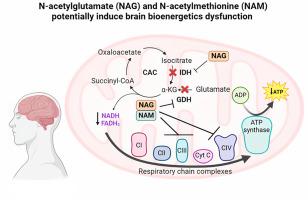Biochemical and Biophysical Research Communications ( IF 2.5 ) Pub Date : 2023-10-17 , DOI: 10.1016/j.bbrc.2023.149123 Vanessa Trindade Bortoluzzi 1 , Rafael Teixeira Ribeiro 1 , Camila Vieira Pinheiro 1 , Ediandra Tissot Castro 1 , Tailine Quevedo Tavares 1 , Guilhian Leipnitz 1 , Jörn Oliver Sass 2 , Roger Frigério Castilho 3 , Alexandre Umpierrez Amaral 4 , Moacir Wajner 5

|
Aminoacylase 1 (ACY1) deficiency is an inherited metabolic disorder biochemically characterized by high urinary concentrations of aliphatic N-acetylated amino acids and associated with a broad clinical spectrum with predominant neurological signs. Considering that the pathogenesis of ACY1 is practically unknown and the brain is highly dependent on energy production, the in vitro effects of N-acetylglutamate (NAG) and N-acetylmethionine (NAM), major metabolites accumulating in ACY1 deficiency, on the enzyme activities of the citric acid cycle (CAC), of the respiratory chain complexes and glutamate dehydrogenase (GDH), as well as on ATP synthesis were evaluated in brain mitochondrial preparations of developing rats. NAG mildly inhibited mitochondrial isocitrate dehydrogenase 2 (IDH2) activity, moderately inhibited the activities of isocitrate dehydrogenase 3 (IDH3) and complex II-III of the respiratory chain and markedly suppressed the activities of complex IV and GDH. Of note, the NAG-induced inhibitory effect on IDH3 was competitive, whereas that on GDH was mixed. On the other hand, NAM moderately inhibited the activity of respiratory complexes II-III and GDH activities and strongly decreased complex IV activity. Furthermore, NAM was unable to modify any of the CAC enzyme activities, indicating a selective effect of NAG toward IDH mitochondrial isoforms. In contrast, the activities of citrate synthase, α-ketoglutarate dehydrogenase, malate dehydrogenase, and of the respiratory chain complexes I and II were not changed by these N-acetylated amino acids. Finally, NAG and NAM strongly decreased mitochondrial ATP synthesis. Taken together, the data indicate that NAG and NAM impair mitochondrial brain energy homeostasis.
中文翻译:

N-乙酰谷氨酸和 N-乙酰甲硫氨酸损害发育中大鼠大脑中的线粒体生物能稳态和谷氨酸氧化:对 ACY1 缺乏症发病机制的潜在影响
氨酰化酶 1 (ACY1) 缺乏症是一种遗传性代谢性疾病,其生化特征是尿中脂肪族N-乙酰化氨基酸浓度高,并与广泛的临床谱和主要神经系统症状相关。考虑到ACY1的发病机制实际上尚不清楚,并且大脑高度依赖于能量产生,因此在体外, ACY1缺乏时积累的主要代谢物N-乙酰谷氨酸(NAG)和N-乙酰甲硫氨酸(NAM)对能量产生的酶活性的影响在发育大鼠的脑线粒体制剂中评估了柠檬酸循环(CAC)、呼吸链复合物和谷氨酸脱氢酶(GDH)以及 ATP 合成。NAG轻度抑制线粒体异柠檬酸脱氢酶2(IDH2)活性,中度抑制异柠檬酸脱氢酶3(IDH3)和呼吸链复合物II-III的活性,并显着抑制复合物IV和GDH的活性。值得注意的是,NAG 诱导的对 IDH3 的抑制作用是竞争性的,而对 GDH 的抑制作用是混合的。另一方面,NAM 适度抑制呼吸复合物 II-III 的活性和 GDH 活性,并强烈降低复合物 IV 的活性。此外,NAM 无法改变任何 CAC 酶活性,表明 NAG 对 IDH 线粒体亚型具有选择性作用。相反,柠檬酸合酶、α-酮戊二酸脱氢酶、苹果酸脱氢酶以及呼吸链复合物I和II的活性不被这些N-乙酰化氨基酸改变。最后,NAG 和 NAM 强烈降低线粒体 ATP 合成。综上所述,数据表明 NAG 和 NAM 会损害线粒体脑能量稳态。































 京公网安备 11010802027423号
京公网安备 11010802027423号